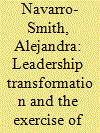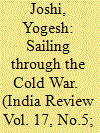| Srl | Item |
| 1 |
ID:
158473


|
|
|
|
|
| Summary/Abstract |
A short contextual overview of the past and present opens up a discussion of the challenges surrounding American Indian leadership in the contemporary world and into the future. We survey some of the literature on Native American leadership and consider leadership issues in institutional settings such as academia, tribal governments, pan/inter-Indian organizations, public interest and NGO groups, and global Indigenous structures, suggesting ways in which non-Native organizations can better recognize, respect, and partner with American Indian leaders.
|
|
|
|
|
|
|
|
|
|
|
|
|
|
|
|
| 2 |
ID:
084365


|
|
|
|
|
| Publication |
2008.
|
| Summary/Abstract |
This article presents an ethnographic analysis of three indigenous leadership types and their formation in contemporary Chiapas. In their interaction with state institutions-and with its policies for political organization and economic development, these cases show the leadership strategies they use to benefit their communities and to help understand local definitions of power. In San Jer nimo Tulij , the area under study, the regional state formation process is the historical framework where local practices and beliefs are shaped and reshaped during daily interactions. This paper shows how some communitarian factions were formed in the context of commercial interactions introduced by development projects brought into the state; these evolved into political divisions that are still recognizable in the context of the low intensity warfare experienced in this region. Therefore, an anthropological-historical perspective is needed to grasp how fighting in or against the Zapatista Army of National Liberation (EZLN) is closely linked to historic local struggles and disputes.
|
|
|
|
|
|
|
|
|
|
|
|
|
|
|
|
| 3 |
ID:
163317


|
|
|
|
|
| Summary/Abstract |
It took approximately two decades for the Indian Navy to acquire submarines even when the first naval plan prepared by the Naval Headquarters in New Delhi and informally submitted to the British Admiralty in September 1947 contained an active submarine component. Other littoral navies in the Indian Ocean went for submarines much earlier. Using Indian, British, and U.S. archives, this article argues that the delay in India’s submarine arm was largely a result of the vagaries of the Cold War. Both Britain and the United States wanted the Indian Navy to contribute to the Western effort for a collective defense against the communist threat, which was largely conceived to be submarine based. This resulted in a surface heavy force structure. However, as India’s threat perceptions changed in 1960s, its quest for submarines gained momentum. When negotiations with the Western powers did not result in anything concrete, Indian Navy turned to the Soviets for initiating its own submarine arm. This decision had long-term implications for the Indian Navy as its underwater fleet thereafter remain dependent upon Soviet assistance for the rest of the Cold War.
|
|
|
|
|
|
|
|
|
|
|
|
|
|
|
|